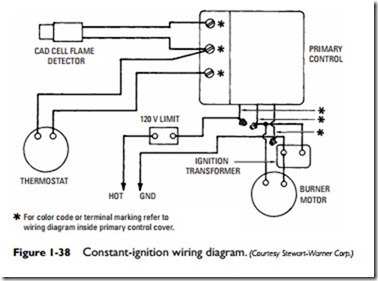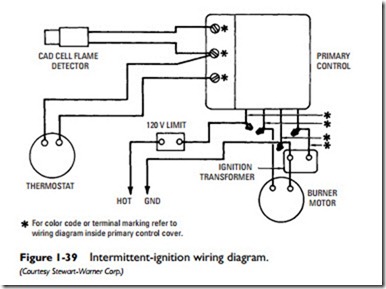Primary Safety Control Service
The cadmium detection cell is the most effective type of primary safety control used on oil burners. Malfunctions cause primary safety control to build up electrical resistance across the cell until the burner is automatically shut off. As soon as the burner shuts off, a reset button pops up on the burner. The button must be reset (pushed down) to restart the burner.
Caution
If the burner does not restart when the reset button is pushed down, do NOT keep resetting the button. Doing so will flood the firebox with oil. If ignition does not take place, the flooded firebox could result in a fire or an explosion.
The primary safety control can be tested by removing the motor lead from the burner and allowing the ignition circuit to be energized. Figures 1-38 and 1-39 illustrate two typical wiring diagrams for primary safety controls.
Installing an Oil Burner
Under most circumstances, oil burners and oil-fired units should be installed in rooms that provide adequate clearance from the combustible material. The only exception to this rule is when specific instructions are given otherwise. In this case, the manufacturer pro-
Some sort of manual shutoff control should be provided for the oil burner in order to stop the flow of oil to the burner when the air supply is interrupted. This must be placed at a safe distance from the unit and in a convenient location. These manual shutoff valves generally consist of either a switch in the burner supply circuit (for electrically driven units) or a shutoff valve on the oil sup- ply line.
Primary safety controls (automatic shutoff devices) must be pro- vided for all oil burners and oil-fired units that operate automatically without the need of an attendant on duty—in other words, those types of equipment found where a stationary engineer would not be employed (i.e., noncommercial and nonindustrial locations).
One problem encountered when converting solid-fuel heating equipment to oil use is the accumulation of potentially dangerous vapors in the ashpit of the unit. This can be avoided by removing the ash door or by providing bottom ventilation to the unit. This precaution is unnecessary if the ashpit also serves as a part of the combustion chamber.
Never install or permit the installation of an oil burner until the boiler or furnace has first been inspected and found to be in good condition. The flue gas passages must be tight and free of any leaks.
All oil burners listed by Underwriters Laboratories, Inc., and Underwriters Laboratories of Canada meet the safety requirements detailed in the various booklets of the National Fire Protection Association.

